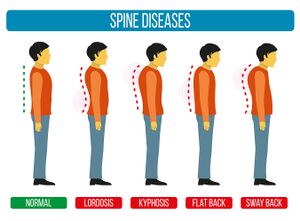Postural Changes Affecting Voice Production
Introduction[edit | edit source]
There are a number of common postural changes that can affect function, pain and disability levels and voice production.
In older adults, the following postural features are commonly observed:[1]
- Increased thoracic kyphosis
- Reduction in intervertebral disc height
- Loss of bone mass
- Forward head position (i.e. anteposition)
- Retraction of muscle chains
- Reduced elasticity and strength
- Cartilage ossification in the larynx
These postural changes can have a significant impact on speech and swallowing function.[1] Examples include:
- Lordosis of the cervical spine inhibits laryngeal elevation and affects swallowing - postural rehabilitation may be beneficial to manage this[2]
- Ossification of the anterior longitudinal ligament can lead to dysphagia - the extent of which is influenced by the thickness of osteophytes, cervical mobility, and cranio-cervical alignment[3]
When specific postural abnormalities are detected, it is important to determine if the client’s posture can be corrected, or if the postural condition is fixed.
Structured Posture[edit | edit source]
Structured posture describes postural disorders where there are underlying morphological abnormalities in the bone / soft tissues. Examples of a structured posture are:[4]
- Idiopathic scoliosis
- Scheuermann juvenile kyphosis
- Congenital vertebral malformation
- Sequels of spine osteomyelitis
- Spondylolisthesis
These conditions are more clinically significant as they are less flexible and can only be modified with difficulty.[1] They require a specific diagnosis and management.[4]
Non-Structured Posture[edit | edit source]
A non-structured posture is modifiable with the help of the therapist.[1] Individuals with non-structured postures may have similar clinical features as those with structural abnormalities.[4] For instance, scheuermann's disease is often mistaken for adolescent postural kyphosis, so it is necessary to differentiate the two conditions based on the physical examination and radiographic analysis.[5]
Antalgic Posture[edit | edit source]
Antalgic postures are technically modifiable but, if corrected, the patient complains of pain.[1]
Compensatory Posture[edit | edit source]
Compensatory postures can be actively and passively corrected, but the patient does not tend to stay in the corrected position. NB If the cause of the compensation is not treated, the postural destabilisation will return in time.[1]
When observing patients, it is important to compare the patient's posture with "normal" posture.
Common Non-Structural Postures[edit | edit source]
Common postural deformities can be viewed from the side, as is seen in Figure 1.
Lordotic Posture:[4]
- Increased lumbar lordosis
- Increased pelvic anteversion (anterior tilt), which leads to increased hip flexion
- Knees may be hyperextended, which causes plantar flexion at the ankle
- The head line runs posteriorly to the lumbar vertebral bodies, and anteriorly to the knee joint axis
- Increased thoracic
- Head protraction
- Flattened or reversed lower cervical lordosis, with increased upper cervical lordosis
- Protraction of the shoulders
- Pronounced abdomen
- There may be deformation of the rib cage, which can affect inspiration
- There may be anteversion of the pelvis
- There may be cervical osteophytosis (i.e. the formation of bone spurs) and possible stress at the upper part of the oesophagus and dysphagia
- The head line is anteriorly to the thoracic spine, lumbar vertebral bodies, and hip and knee joint axis
- Loss of lumbar lordosis
- Flattened lower part of thoracic kyphosis, but increased upper thoracic region
- Potentially kyphotisation at the cervico-thoracic junction
- There may be a forward head position
- Either neutral pelvis or decreased anterior tilt
- Retraction of the hamstring muscles
- The head line and the base line usually overlap and pass anteriorly to the lumbar vertebral bodies and posterior to the hip joint axis. The head may be shifted anteriorly to the base line.
- Anterior pelvic shift
- Thoracic kyphosis, which extends into the upper lumbar spine
- Shorter lumbar lordosis
- Normal or slightly decreased anterior pelvic tilt
- The dorsal spine is displaced posteriorly while the head and pelvis are anterior to the plumb line
References[edit | edit source]
- ↑ 1.0 1.1 1.2 1.3 1.4 1.5 1.6 1.7 1.8 Banfi M. Postural Principles Useful in Speech Therapy. Physioplus. 2021.
- ↑ Sato K, Chitose SI, Sato K, Sato F, Ono T, Umeno H. Dysphagia precipitated by cervical lordosis in the aged. Ear Nose Throat J. 2020:145561320946644.
- ↑ Nishimura H, Endo K, Aihara T, Murata K, Suzuki H, Matsuoka Y et al. Risk factors of dysphagia in patients with ossification of the anterior longitudinal ligament. J Orthop Surg (Hong Kong). 2020;28(3):2309499020960564.
- ↑ 4.0 4.1 4.2 4.3 4.4 4.5 4.6 Czaprowski D, Stoliński Ł, Tyrakowski M, Kozinoga M, Kotwicki T. Non-structural misalignments of body posture in the sagittal plane. Scoliosis Spinal Disord. 2018;13:6.
- ↑ Horn SR, Poorman GW, Tishelman JC, Bortz CA, Segreto FA, Moon JY et al. Trends in treatment of scheuermann kyphosis: A study of 1,070 cases from 2003 to 2012. Spine Deform. 2019;7(1):100-106.







